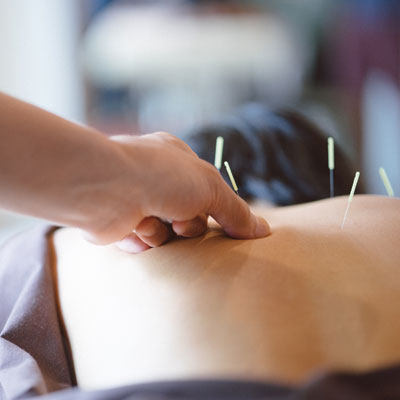Dry Needling
 Dry needling is a modality that has evolved from traditional acupuncture. It refers to the insertion of ultra-thin needles into the muscles and connective tissues of the body. The purpose is to deactivate trigger points. As a result, pain can be alleviated.
Dry needling is a modality that has evolved from traditional acupuncture. It refers to the insertion of ultra-thin needles into the muscles and connective tissues of the body. The purpose is to deactivate trigger points. As a result, pain can be alleviated.
Potential Benefits of Dry Needling
Though dry needling doesn’t cure anything, it may help with the following:
- Relieves pain
- Alleviates muscle tension
- Boosts range of movement around a joint
- Improves circulation
- Promotes a greater healing response
What About Massage Therapy?
You may be wondering if massage therapy can address chronic trigger points. These types of trigger points can be challenging to reach with deep tissue massage. Dry needling, however, is very successful at deactivating chronic trigger points that “won’t let go” with massage therapy. Dry needling is highly specialised and requires many years of training and practice.
Why Consider Dry Needling?
- For most people, dry needling produces less discomfort than deep tissue massage.
- Dry needling can get trigger points deep within muscle tissue that may not be accessible with massage therapy (up to 10 cm deep).
- Dry needling can cause a trigger point to release in mere seconds. On the other hand, a massage therapist may need to work on a trigger point for 5-10 minutes to get it to release.
- Dry needling offers fast relief. When trigger points are the source of your pain, and dry needling is administered correctly to release those trigger points, pain relief should occur straightaway and continue for the next 1-2 days.
How Many Sessions Will I Need?
When we determine that your pain is coming from trigger points, and when dry needling is performed properly to alleviate those trigger points, pain should resolve considerably in 1-2 treatment sessions. If your pain is not alleviated, the therapist will reassess the pain patterns to determine an alternative diagnosis.
FAQ
How is dry needling different from acupuncture?
Acupuncture offers pain relief for muscles through the release of endorphins and by promoting balance in the energy levels of the body. It also has anti-inflammatory effects on the muscular tissue.
Conversely, dry needling relieves pain by de-activating the trigger points of the muscle cells.
In which situations would dry needling be used?
- Simple muscle tightness
- Strains and sprains
- An overworked body needing recovery
- Muscle activation
- Swelling reduction
Are there any side effects associated with dry needling?
Schedule Your Visit Today
Would you like to find out if dry needling may benefit you? Contact our South Perth practice today to book an appointment!
CONTACT US

